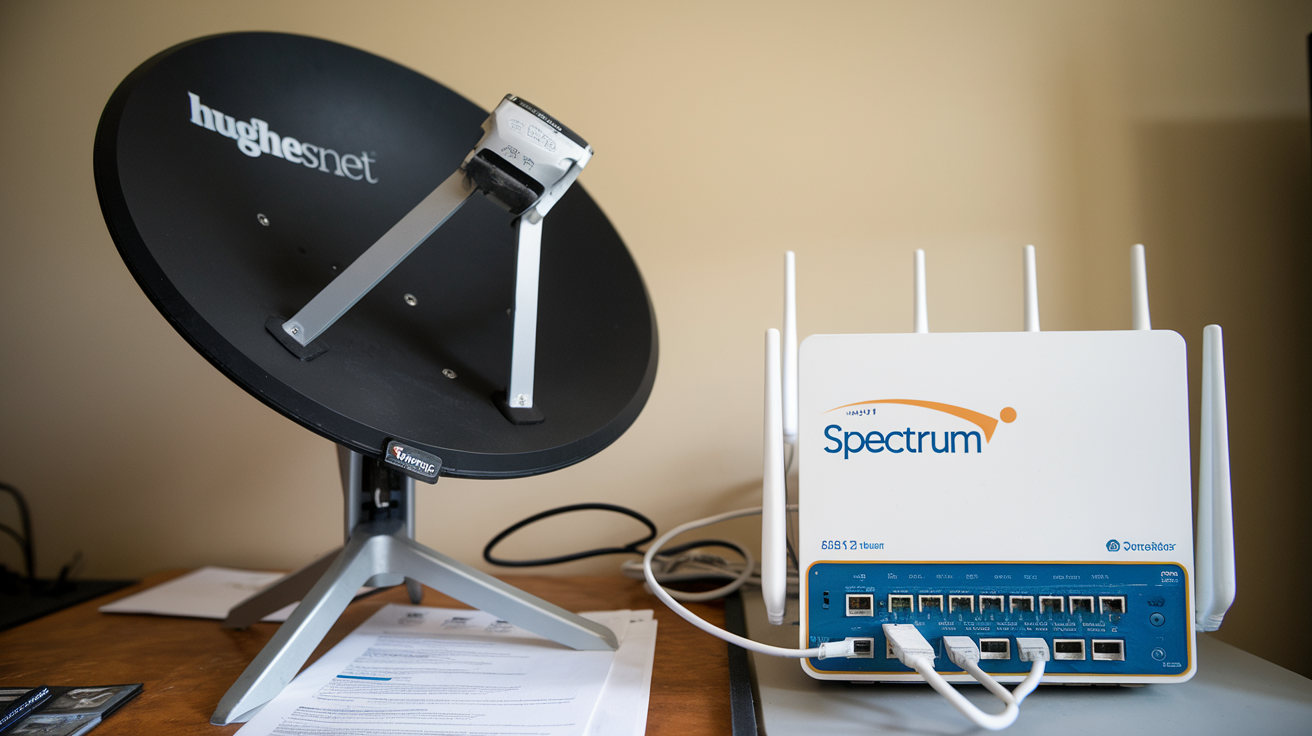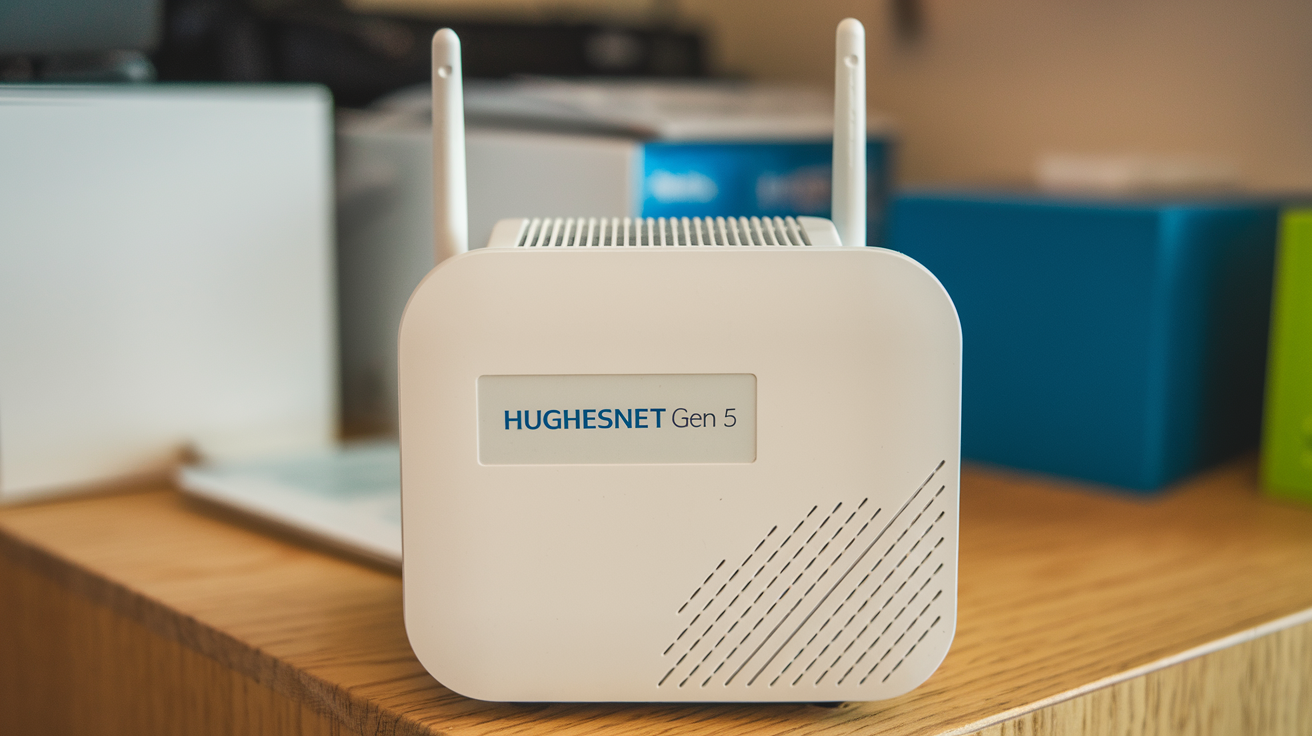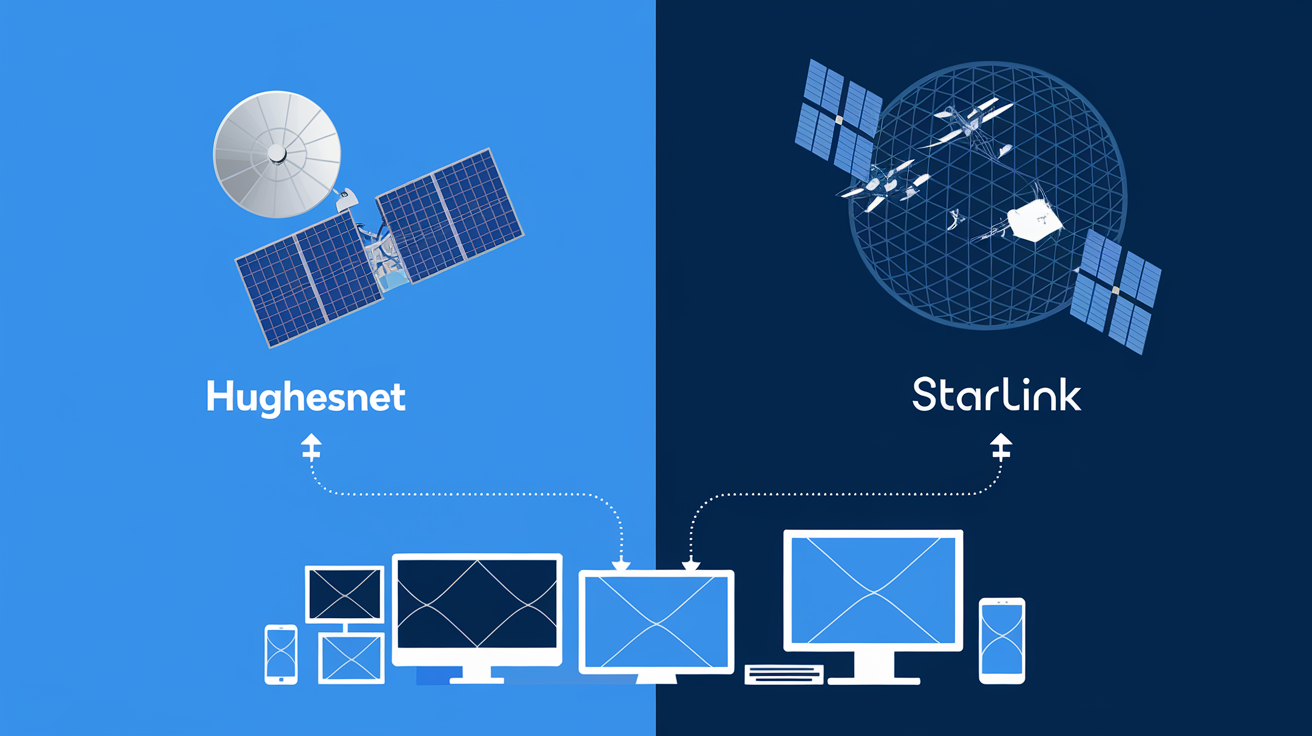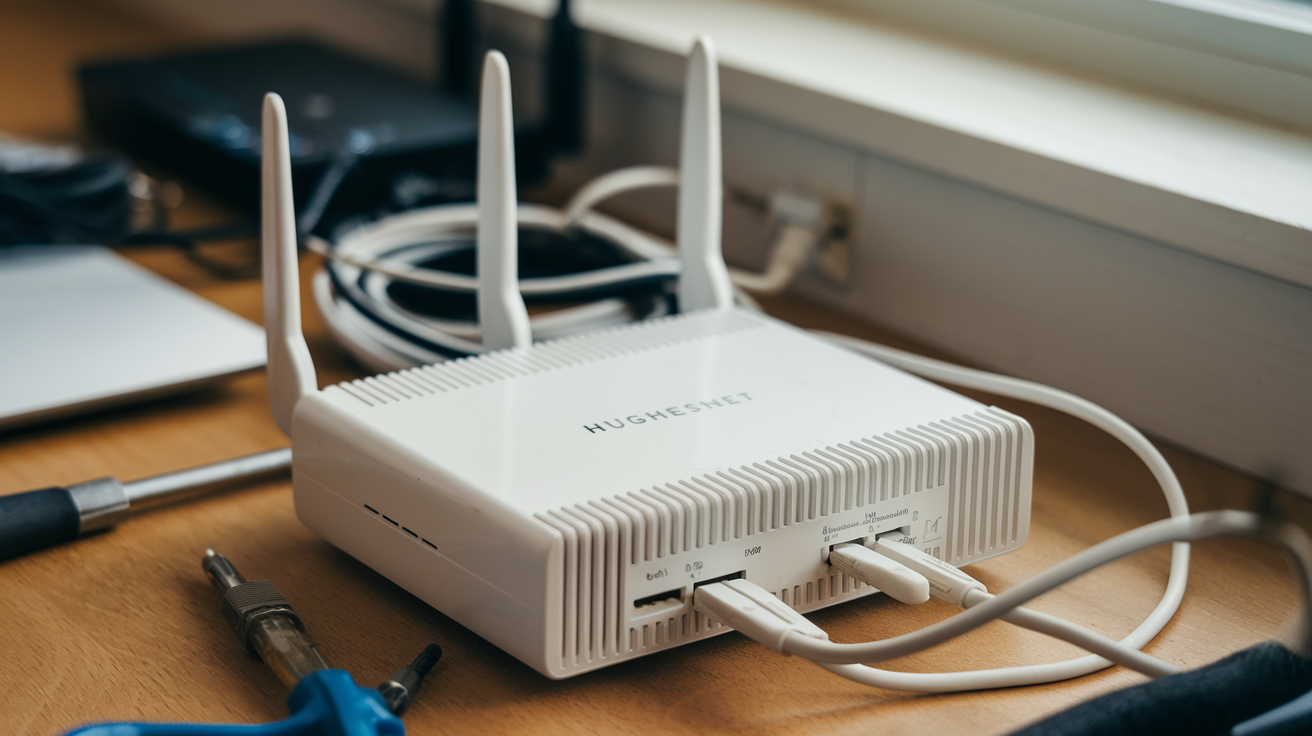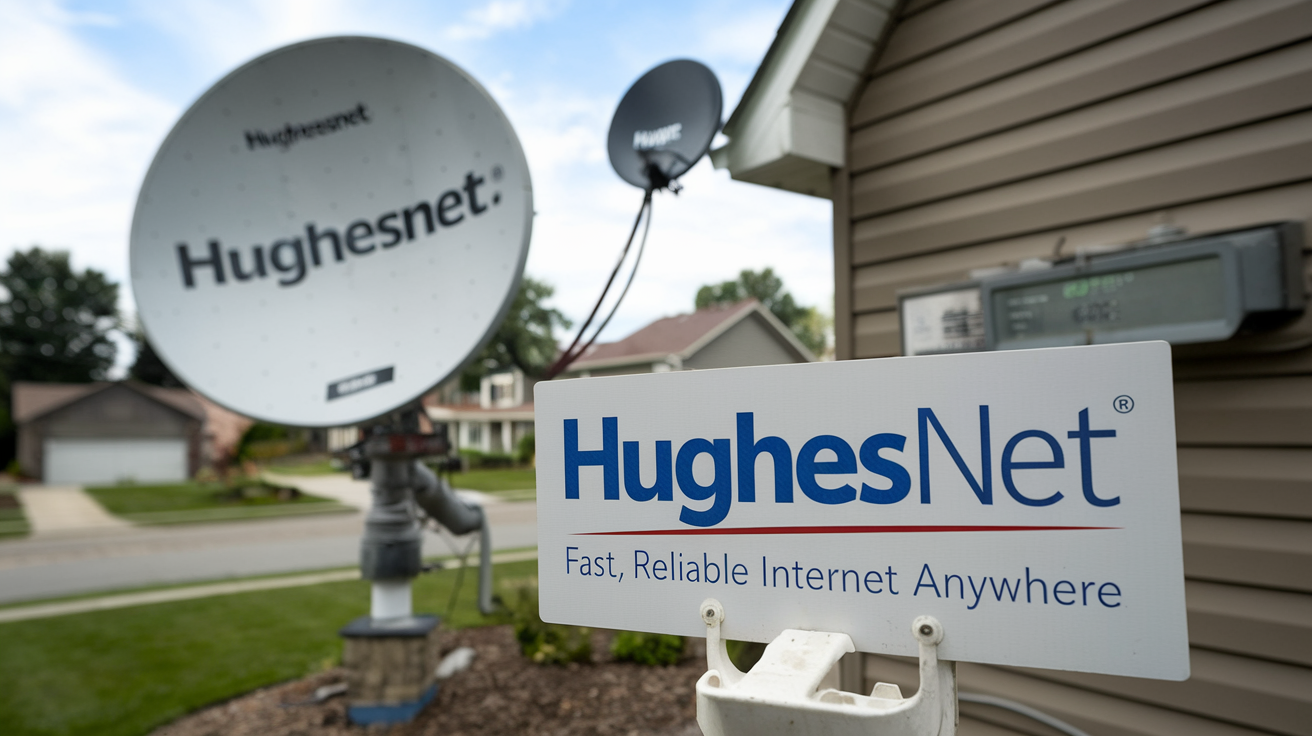-
Posted on: 25 Dec 2024
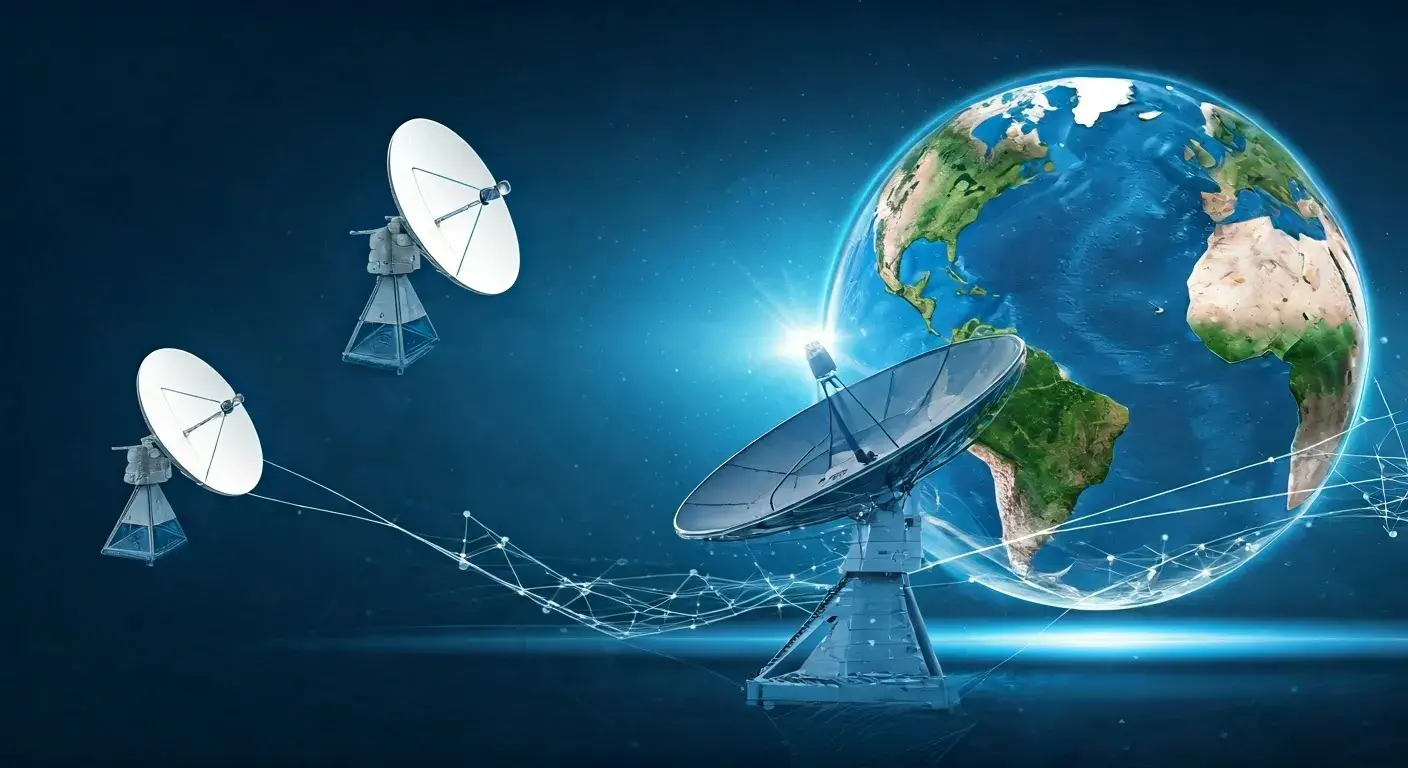
-
For people living in remote areas or places without good wired internet, satellite internet is a great option. This technology goes beyond location limits, sending high-speed internet service straight to you. In this detailed comparison, we look at two big names in satellite internet: Starlink and HughesNet. We will review what they offer and point out key differences. Our goal is to help you find the best choice for your needs.
Understanding Satellite Internet
Satellite internet has changed how people access the internet, especially in places where cable and fibre connections don't reach. It sends data between your location and satellites in space. This means it does not rely on ground-based networks.
This service is very helpful for people in remote areas or needing internet access while travelling. However, it is important to note that there are some limits, like changes in speed and possible disruptions due to weather.
The Basics of Satellite Internet Connectivity
Satellite internet connects you to the internet by sending and receiving data through satellites that orbit Earth. To use it, you need a satellite dish at your home. This dish talks to the satellites, allowing information to move to and from your devices.
A key feature of traditional satellite internet is high latency. This means there can be a small wait between when you ask for data and when you see it on your screen. This delay happens because the signals travel a long way to geosynchronous orbit, where most satellite internet providers place their satellites.
Even with this delay, satellite internet is a big help for people in areas where regular internet service is lacking. It provides an important way to stay connected, work from home, and access online resources, no matter where you are.
Evolution of Satellite Internet: From HughesNet to Starlink
HughesNet has been a well-known name in satellite internet service for many years. It has provided reliable internet to many users. However, Starlink, started by Elon Musk's SpaceX, has changed the game in this field.
Starlink uses many low Earth orbit (LEO) satellites that are much closer to the Earth than older geosynchronous satellites. This setup leads to lower latency and possibly faster internet speeds.
With Starlink’s arrival, satellite internet has reached a new level of speed and response time. As competition grows, users can enjoy better technology and more choices in internet service.
Introduction to Starlink
Starlink is becoming a big player in satellite internet. It uses a group of low Earth orbit (LEO) satellites to provide fast internet access. This new method from SpaceX, led by Elon Musk, wants to change how people connect around the world.
Starlink focuses on lowering delays and increasing speeds. It wants to help people and communities that don’t have good traditional internet access. Let’s look at how Starlink is unique and how it might change the future of satellite internet technology.
How Starlink is Changing the Game in Satellite Internet
Starlink is changing the game by using low Earth orbit (LEO) satellites. These satellites are much closer to Earth than traditional satellites that sit in geostationary orbit. Being closer means data travels shorter distances. This leads to lower latency and faster speeds.
Starlink's satellite internet service can offer speeds like or even quicker than DSL or cable internet. For people used to the slow speeds of regular satellite internet, Starlink's performance is impressive.
Starlink is also growing its satellite constellation. New launches keep adding more coverage and improving network capacity. This shows that Starlink wants to be a strong player in the global internet service provider market.
Starlink Internet Plans and Pricing
Starlink offers a simplified approach to internet plans, focusing on speed and data prioritization rather than tiered options. The basic "Starlink" data plan provides unlimited data with speeds ranging from 25-100Mbps. However, during peak hours, users might experience reduced speeds as network traffic is prioritized for those on the "Starlink Priority" plan.
The "Starlink Priority" plan, priced at $140-$500/month, offers faster speeds (40-220Mbps) and a data allowance of 40GB to 2TB of "priority data," ensuring consistent performance even during peak hours. Both plans come with an upfront cost of $349-$2,500 for the Starlink dish and router.
While the upfront cost may seem steep, the potential for high-speed, low-latency internet in previously underserved areas has attracted a rapidly growing base of Starlink users.
The Technology Behind Starlink’s Success
Central to Starlink's success is its unique satellite network. Starlink sends thousands of small satellites into low Earth orbit. This setup gives much lower latency than regular satellite internet providers. The satellites talk to ground stations and user devices. Together, they create a mesh network that covers a larger area and offers faster data transfer.
Unlike many traditional satellite internet services that have data caps and often slow your connection, Starlink gives unlimited data with its standard home plan. This means users do not have to worry about exceeding data limits. They can stream, game, and download without checking how much data they use all the time.
Starlink's technology is always getting better. SpaceX frequently launches new satellites to improve the network and expand its reach. This ongoing drive for progress leads to faster speeds, better reliability, and more access to high-speed internet worldwide.
A Closer Look at HughesNet
HughesNet is a well-known brand in satellite internet. They have served customers for many years and have a lot of experience in providing internet access. They operate a network of satellites that stay in one spot in the sky. This gives them wide coverage across the United States.
Their technology is not as new as Starlink's low Earth orbit network. However, HughesNet still provides reliable internet access to many users. They focus on offering good service at fair prices. This makes them a good choice for people who want to save money.
HughesNet’s Place in the Satellite Internet Market
HughesNet plays an important role in the satellite internet market. It mainly serves areas where other high-speed internet options are not available. The company has been in this field for a long time. They provide satellite service to many customers in rural and underserved areas.
One thing that sets HughesNet apart is its well-built infrastructure and easy installation process. The company offers professional installation. This means they will make sure the satellite dish and modem are set up correctly for the best service. This is helpful for users who may not know much about satellite internet technology.
Even though HughesNet may not be as fast as newer services like Starlink, it still offers reliable internet access. This makes HughesNet a good choice for people looking for a consistent connection in places where there aren't many alternatives.
HughesNet Internet Plans and Pricing
HughesNet provides different internet plans to meet various needs and budgets. They are cheaper than Starlink, but this means users may experience slower speeds and lower data caps. The plans usually cost between $60 and $160 each month, with download speeds only reaching about 25Mbps.
All HughesNet plans include data caps that are between 10GB and 50GB a month. If you use more data than what your plan allows, your internet speed may drop a lot. This can affect things like streaming videos or having video calls. If you need more data, you can buy extra data tokens.
Even with these limitations, HughesNet is still a good choice for people looking for an affordable satellite internet option. Their lower monthly prices and simple plans make them a smart pick, especially for those who do not use a lot of internet.
The Strengths and Limitations of HughesNet
HughesNet has some clear advantages, making it a good choice for certain internet users. First, it is affordable. This helps budget-minded customers as it is a cheaper option compared to the more expensive fees of Starlink. However, there are some limits to HughesNet's technology. A major issue is higher latency. This means that users may face delays while browsing, gaming, or during video calls. This can be a source of frustration for them.
Also, the slower speeds and data limits with HughesNet plans may not work well for users who need a lot of bandwidth. People who love streaming or families who heavily depend on the internet for work or entertainment might find the HughesNet plans to be too restrictive.
Starlink vs. HughesNet: Detailed Comparison
Choosing between Starlink and HughesNet is not just about looking at internet speeds and monthly costs. You need to know the special benefits and drawbacks of each satellite internet provider. Think about your own needs, budget, and location to help you make a smart choice.
This detailed comparison explores important points like speed and performance, pricing and data plans, coverage, customer service, and what real users say. We will look at the pros and cons of each provider. This will help you understand what is best for your needs.
Speed and Performance: A Side-by-Side Review
When we look at speed and performance, Starlink is usually better than HughesNet. This is because of its new Low Earth Orbit (LEO) satellite technology. Speed tests show that Starlink often provides faster speeds. These speeds can be close to what you get from cable and fibre internet providers.
Starlink also has much faster upload speeds compared to HughesNet. This is very important for doing things like video calls, online gaming, and sending big files. Both companies say they offer download speeds up to 100Mbps or better. But Starlink usually sticks to those promises better than HughesNet, which can have slower speeds and changes, especially during busy times.
Keep in mind that your internet speed can change based on where you are, whether satellites can connect, and the weather. Overall, Starlink tends to perform better, giving users a smoother and faster online experience.
Pricing and Plans: Which Offers Better Value?
Choosing the best satellite internet provider depends on what you need. HughesNet is a great choice for people on a budget. They offer plans with lower monthly fees, making it easy for more users to sign up.
On the other hand, Starlink charges more, but they provide faster speeds and lower latency. Their standard residential data plan also has unlimited data. If you want the best performance online, Starlink is a strong option.
Both HughesNet and Starlink also have business plans. These plans are designed for businesses and offer higher data limits, better customer support, and faster speeds. However, these features come at a higher cost.
Coverage and Availability in the United States
Both Starlink and HughesNet have great coverage in the United States. They reach even the most remote locations. Unlike regular internet service providers that may face limits, satellite internet goes beyond geographical borders.
Starlink is growing its coverage as SpaceX sends more satellites into space. Right now, they serve most of the US and have plans for almost worldwide coverage soon. Users can visit Starlink's website to check if the service is available at their address.
HughesNet also covers a large area across the contiguous United States. Their long history in the market has helped them create a strong network. They serve even the most rural and underserved communities.
Customer Service and Support
Customer service matters a lot when picking an internet service provider, especially for complex options like satellite internet. Starlink and HughesNet both have customer support channels, but they do things differently.
Starlink has had some issues with customer service in the past. Many users have mentioned long wait times and support that wasn’t great. Yet, the company is working hard to improve how they help customers.
On the other hand, HughesNet has been around longer and usually gets good reviews for its customer service. They offer 24/7 phone support and have online help tools. Plus, they have an app you can use to manage your account and fix problems.
User Experiences with Starlink and HughesNet
User experience is key for users of Starlink and HughesNet. While technical specs and marketing materials are important, how people use these services truly matters. We need to look at their performance in real-life situations to make smart choices.
This part looks at real feedback from users. We gathered it from online reviews, forums, and social media. This gives us helpful insights about what users like and dislike. By sharing the experiences of real customers, we can see both the strengths and weaknesses of Starlink and HughesNet more clearly.
Real Customer Reviews and Feedback
Customer reviews show mixed opinions about both Starlink and HughesNet. Starlink is praised for its fast speeds and reliable performance. Many users say it has greatly improved their online activities. However, some people are frustrated with the high equipment costs and service outages. They also mention problems with customer support.
HughesNet gets mostly positive feedback for its dependable service and helpful customer support. Users like their simple plans and lower prices, which make it a good choice for those on a budget. However, some customers are unhappy about data caps and slower speeds during busy times.
In the end, choosing the best satellite internet service means thinking about what matters most to you. It's important to know that internet performance can change based on factors like where you live, the weather, and network congestion.
Case Studies: Rural Connectivity Challenges and Solutions
The digital divide shows the big gap in internet access between cities and rural areas. This highlights how important satellite internet providers are in closing this gap. In many parts of the United States, where there is little or no access to cable or fibre internet, satellite internet has become very important. It helps businesses, individuals, and communities get the internet they need.
Think about a rural area where students can't finish their online classes because the internet is not good. When a satellite internet provider like Starlink or HughesNet comes in, it can change everything. Students can access online resources, join virtual classes, and gain knowledge that they couldn't before.
Also, small businesses in remote locations need reliable internet. It helps them compete in today's market. Satellite internet allows these businesses to connect with customers, run operations online, and grow their presence online. This can help boost the economy in areas that have often been left behind in the digital age.
Future Prospects and Developments
The satellite internet world is always changing. Starlink and HughesNet are both putting money into new ideas and growth. As technology gets better and more people want high-speed internet access, we can expect cool new developments.
We might see new satellite systems and innovative technologies that will lower wait times and increase speeds. The future of satellite internet looks bright, with faster, easier, and more reliable connections for people and communities everywhere.
Upcoming Innovations in Satellite Internet
The world of satellite internet is changing fast. It promises to change how we connect and use information online. New ideas are coming that aim to provide faster speeds, lower latency, and better internet options for people everywhere.
One exciting update is the growth of laser-linked satellites. These new satellites use lasers to talk to each other instead of radio waves. This change can greatly increase data transfer speeds and lower latency, making it work more like fibre optic internet.
Also, making satellite technology smaller means more affordable and portable internet access. Companies are creating smaller, strong satellite dishes that can be set up easily in remote areas. This helps bring high-speed internet to communities that need it the most.
What the Future Holds for Starlink and HughesNet
Starlink's future looks promising. This is because of their ambitious plans and new technology. The company wants to launch many more satellites into space. This will help them cover more areas and increase their network capacity to support many more users. The launch of Starlink Mini, a smaller and cheaper satellite dish, shows that they want to reach even more customers.
HughesNet, which is more established, will likely work on improving its current setup and making its services more affordable. They may not match Starlink's speeds, but they will focus on providing reliable service at good prices, which will attract certain internet users.
However, new high-speed internet options like 5G fixed wireless and fibre optic networks may create challenges for both satellite internet providers. Companies like Google Fiber and Verizon are offering gigabit internet speeds in some areas, which could take away market share in the future.
Conclusion
In conclusion, picking between Starlink and HughesNet depends on your internet needs and where you live. Starlink uses new technology that gives good solutions for satellite internet. They offer competitive prices and are growing their coverage. HughesNet has been around for a long time and gives reliable service, but it has different speeds and data caps. It is important to think about speed, pricing, availability, and customer support when you make your choice. Both services have good points and some downsides, so think carefully based on what you need most. To better understand, look at real customer reviews and feedback to help you choose wisely.
FAQ
-
What is the main difference between Starlink and HughesNet?
Starlink uses LEO satellites for faster speeds (25–220 Mbps) and lower latency (20–60 ms), while HughesNet uses GEO satellites with slower speeds (up to 100 Mbps) and higher latency (600–800 ms). -
Which provider is faster?
Starlink offers download speeds of 25–220 Mbps (median 104.71 Mbps) and upload speeds of 5–25 Mbps, compared to HughesNet’s 25–100 Mbps download (often 1–42 Mbps) and 1–5 Mbps upload. -
Does Starlink have data caps?
No, Starlink offers unlimited data with no throttling, though speeds may slow during peak hours for Residential Lite plans. -
Does HughesNet have data caps?
HughesNet offers unlimited data with soft caps (100–200 GB). Speeds reduce to 1–3 Mbps after priority data is used. -
Is installation difficult for either provider?
Starlink allows easy self-installation with a compact dish and app guidance. HughesNet requires professional installation, which is free with equipment leasing. -
Can I use Starlink or HughesNet for gaming?
Starlink’s low latency (20–60 ms) supports gaming, while HughesNet’s high latency (600–800 ms) makes it unsuitable for most gaming. -
Which is better for rural areas?
Both are excellent for rural areas, but Starlink offers faster speeds and lower latency, while HughesNet is more affordable. -
Are there contracts with Starlink or HughesNet?
Starlink has no contracts, allowing cancellation anytime. HughesNet requires a 2-year contract with early termination fees. -
How does weather affect performance?
Both can experience disruptions from heavy rain or snow, but Starlink’s LEO satellites are less impacted than HughesNet’s GEO satellites. -
Which provider has better customer service?
Starlink has mixed reviews but generally better feedback for performance. HughesNet faces criticism for poor customer service and billing issues. -
Can I use Starlink or HughesNet for mobile applications?
Starlink offers mobile plans for RVs, boats, and aviation. HughesNet is for fixed locations only. -
What are the equipment costs?
Starlink’s equipment costs $349–$1,499 (one-time). HughesNet’s is $300–$450 (one-time) or $15–$20/month lease. -
Is Starlink available everywhere in the US?
Starlink covers 99.7% of US households, but some areas may still be waitlisted. HughesNet is available nationwide. -
Can I use a VPN with either service?
VPNs work better with Starlink due to lower latency. HughesNet’s high latency can reduce VPN speeds by 50–70%. -
Which is more cost-effective?
HughesNet is cheaper for light users ($39.99–$95/month), while Starlink’s higher cost ($50–$250/month) is justified for heavy users needing speed and unlimited data.
-
